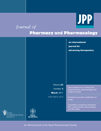Intestinal enzymatic metabolism of drugs
Abstract
Objectives The intestinal stability of perorally administered drugs has so far been determined using simulated intestinal fluid containing porcine pancreatin (SIF/P), as human gastrointestinal fluids are in most cases not available. In this study the metabolism of six low molecular mass drugs in SIF/P was compared with that in freshly collected porcine intestinal juice and on excised porcine intestinal mucosa.
Methods The drugs used were oseltamivir, atazanavir, diloxanide, diltiazem, cephalothin and cefoxitin. Metabolism studies were carried out by incubating each drug in the in-vitro models and by analysing the percentage of unmodified remaining drug at fixed time points.
Key findings Three drugs showed higher degradation on porcine mucosa compared with that in SIF/P and for five compounds a significantly higher metabolism in collected porcine intestinal juice versus SIF/P was observed. Metabolism of diloxanide furoate in collected intestinal juice, for example, was 40-fold higher compared with SIF/P. Moreover, the involvement of different metabolic pathways in porcine mucosa and intestinal juice was observed for cephalothin, being metabolized to desacetylcephalothin and thienyl-acetylglycine, whereas these metabolites were not found in SIF/P. In addition, diltiazem solution (0.25% m/v) was found to be significantly degraded in intestinal juice whereas its metabolism in SIF/P was negligible.
Conclusions These findings demonstrated that the use of SIF/P for evaluation of presystemic drug metabolism could be highly misleading. Incubation of drugs in freshly collected porcine intestinal juice will likely lead to the improvement of the mimicry of body conditions to evaluate presystemic drug metabolism.




